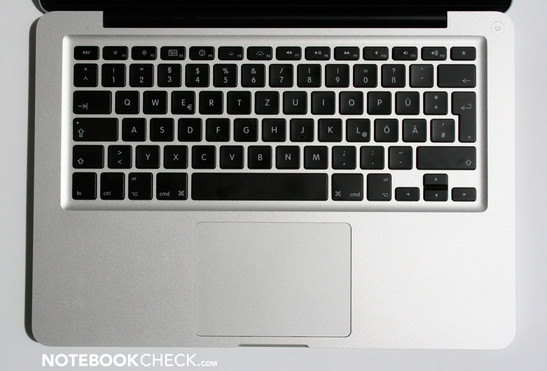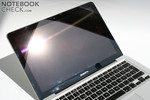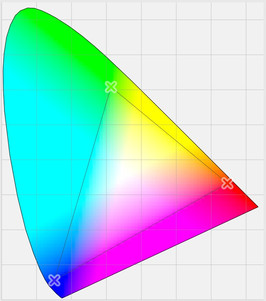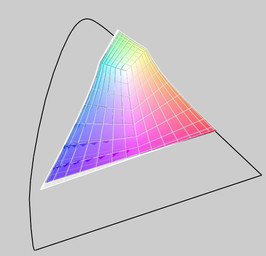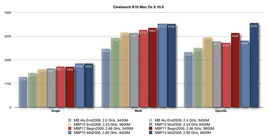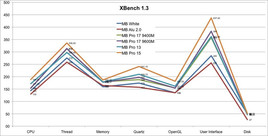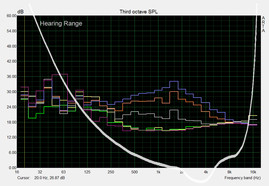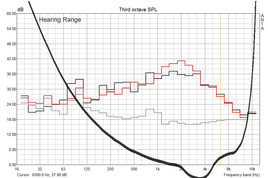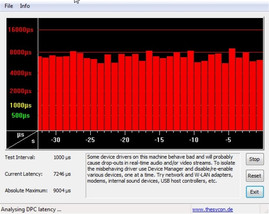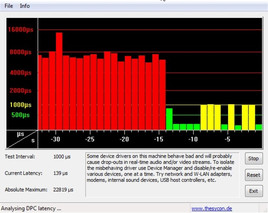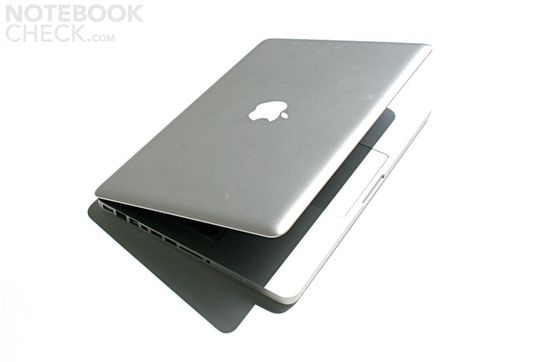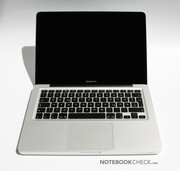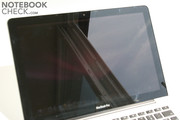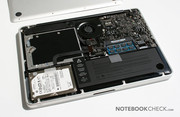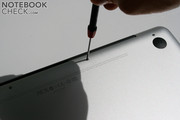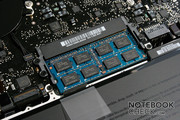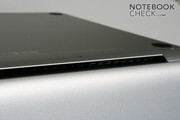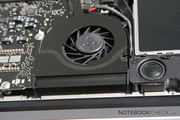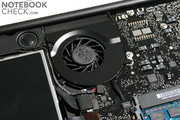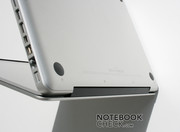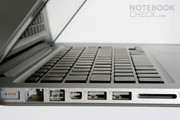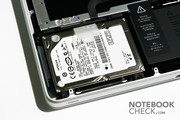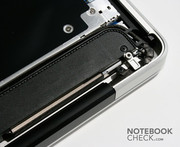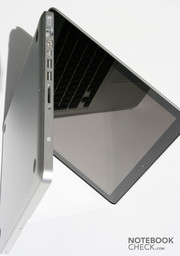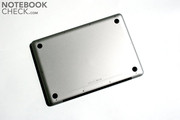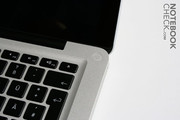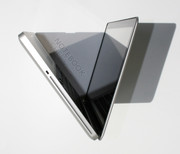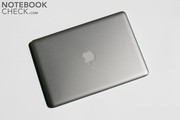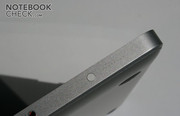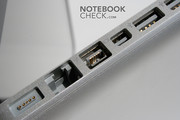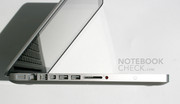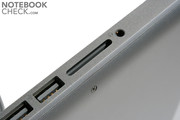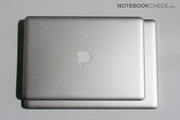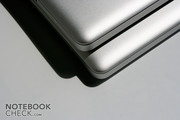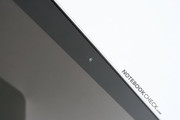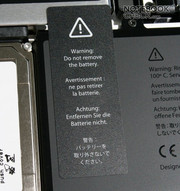Review Apple MacBook Pro 13 inch - Mid 2009
MacBook 13 + Pro.
Again at last, after a rebranding to Pro, the little 13" MacBook Pro can bid a Firewire. Furthermore it received a SD cardreader and a significantly better display. A radical price cut completes the designer-notebook's package. You will discover how the strongest variant of the 13" Pro models with a 2.53 GHz CPU scores in our comprehensive evaluations in the following review.
The 13 inch Pro model of the MacBook range is available in two preconfigured variations. We have received the more expensive alternative with a 2.53 GHz Core 2 Duo (in opposition to a 2.26 GHz processor in the starter model) with 4 GB RAM (versus 2 GB) and a 250 GB hard disk (versus 160 GB HDD) for testing. Apple charges a steep 250 Euros / 300 Dollar surcharge for the stronger hardware. As to the other equipment, both models have been identically constructed; hence the keyboard light is also already integrated into the starter model.
Case
The MacBook's aluminum case dubbed "Unibody" still sets standards for design, haptic, stability and workmanship. The design of the 13" MacBook looks better fitted to its dimensions in comparison to the bigger MacBook Pro models. The stability of the aluminum case is stunning in comparison to other notebooks. Even the, for a majority of notebooks, critical area over the DVD drive doesn't give in at pressure.
Apple has spared out the maintenance flap on the bottom side due to the implantation of the new battery. The only not perfectly deployed component was removed by this. However, you now have to unscrew the sub-shell in order to replace the HDD for instance. The battery can't be removed by the user at all anymore.
One further critique point of the previous Unibody model cases remains. The sharp front edge gets unpleasant for the forearm at longer table use. This is however defused a bit by the case's narrow construction shape.
Connectivity
Obviously Apple has listened to the critique of press and users as they have additionally built in a Firewire 800 port and a SD cardreader. The new interfaces demand their toll, though. The dedicated audio-in was spared. In return, the optical / analog line-out supports the conversion to an analog line-in. Furthermore, the Apple stereo headset with microphone is support by this interface.
Also, the notebook has merely two USB connections, which makes attaining a USB Hub recommendable. One more point of critique is the built-in mini display port. In order to connect most monitors, an even more expensive adapter from Apple has to be budgeted. Besides, Apple doesn't even have an HDMI adapter - also, the audio signal isn't interwoven with the display signal, which restricts third-party adapters somewhat. A positive aspect of the small monitor interface is the option to connect 30" displays with a resolution of 2560x1600 (i.e. via an expensive Dual-Link DVI adapter).
The 13" MacBook Pro has a good wireless configuration. Aside from an 802.11n (draft) compatible WLAN card from Broadcom (BCM4322AG), the Apple laptop also has Bluetooth 2.1 + EDR. UMTS or WiMax are also not available optionally and have to be equipped via an USB stick on one of the precious USB ports.
Apple includes the newest Mac OS 10.5.7 Leopard operating system as software and the application suite iLife 2009. Thus a starter is actually set up for all common applications.
Apples grants a 12 month warranty as standard. This can be extended to 36 months for a whopping 249 Euros (support inclusive).
Input Devices
Single-keyed keyboard
Apple hasn't changed anything about the input devices since disembarking the Unibody notebook last year. Merely the Window drivers for the glass trackpad have been slightly improved, whereas the use of an external mouse under Windows isn't necessarily required anymore. However, most multi-touch features are still reserved for Mac OS X.
Keyboard
The single keys are, as in the predecessor, embedded directly into the case and have a soft stroke with a palpable pressure point. Thanks to the multiple screwing of the keyboard unit to the full body, the keys sit tight in the case and don't clatter. A deflection is also not possible due to the aluminum case.
The Apple keyboard's layout is well-made for a Mac OS X. Touch-typing was possible straight away without any problems in the test. The small arrow keys (especially unpleasant for gamers) have been kept as well as the narrow return key.
Apple now builds the practical key background light into all Pro models.
As always, Windows PC migrants have to be warned. The layout is optimized for Mac OS X and because of the sparse lettering (i.e. the lettering for the signs:"[] | {}" are missing) you don't get around trial & error attempts in the beginning.
Glass - Trackpad
The trackpad made of glass in the smallest MacBook Pro is identical to the one in the big MacBook Pro Unibody notebooks. The supreme gliding traits and the great drivers for Mac OS X (incl. multi-touch responses) please here, as well. The integrated key may allow for a larger touchpad surface, but the control sometimes needs a bit of accommodation at drag & drop actions.
Display
One large innovation with the launch of the MacBook Pro 13" is the improved display. It is still based on a TN screen, but now represents an enhanced color space and also has more stable viewing angles.
With an average brightness of 209 cd/m2, our test device had a hard time to outshine the profound reflections of the prefixed glass surface. Especially on bright summer days you have to ensure that you don't have a window behind you during use.
The illumination of 79% is rather average and results from the high brightness decrease from the center to the right lower display's edge (227 to 180 cd/m2).
The evident improvement of the new screen is seen at maximum contrast. Our old 2.0 GHz test device still had a weak maximum contrast of 166:1. Due to the much improved black value of 0.3 cd/m2 the new "Pro" notebook achieved an impressive 757:1. This can be subjectively seen in form of noticeably more luscious colors.
| |||||||||||||||||||||||||
Brightness Distribution: 79 %
Contrast: 757:1 (Black: 0.3 cd/m²)
In particular, the improvement of the new MacBook Pro 13 display is seen in the representable color space. As the old MacBook Aluminum couldn't even cope with the colors of the standard RGB color space, the new TN screen is able to fully cover the sRGB color space. Unfortunately, Apple doesn't supply a pre-calibrated ICC file for the included screen. The uncalibrated representation was very cool and definitely over-radiated in our test device (at maximum brightness). The presentation was far better after calibration with the Spyder3Elite from Datacolor.
However, the extended color space could be slightly disturbing even after the calibration, as Mac OS X doesn't consequently support color management in all programs yet (i.e. Quicktime first with Snow Leopard). An interesting report about this can be found in the Apfelquak Blog (German).
The viewing angles have also been improved in comparison to the old display and are therefore already very good for a TN screen. The colors change obviously anyway at stronger inclination from above as well as below.
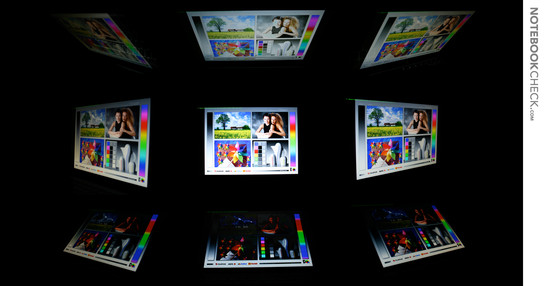
Performance
We assessed the performance of the built-in components in Mac OS X with XBench 1.3 and Cinebench.
Unfortunately, the overall score of XBench 1.3 wasn't constant even after 4 runthroughs and didn't represent the partial results (which were rather constant). Therefore, we haven't included the overall score. The strong MacBook Pro version with a 2.53 GHz Core 2 Duo could practically hoist itself to the level of the previously tested 17" MacBook Pro. This had a 2.7 GHz CPU built-in but reaped a lower CPU score in the XBench. Hence, this result is to be taken with a pinch of salt. Maybe there have been a few enhancements made on the Mac OS X in the meantime, which have led to this increase. The small 13 incher lagged somewhat behind in comparison to the 15" MBP, which we had on our test bench at the same time.
The results of the Cinebench R10 corresponded to those expected. The 13" MacBook Pro remains behind the 15" and 17" models with a stronger CPU. The OpenGL results almost coincide to each other in all models deploying the 9400M graphic chip set.
The little 13" MacBook Pro presented a good performance with Windows Vista Business (installed using Bootcamp), as expected. Merely the gaming performance is slightly spoiled by the integrated 9400M without its own memory. It just enough for low detail settings and resolutions and a few demanding games only achieve short of 30 frames per second. Thus, the one or other studder has to be expected. See also our gaming list, in which many current as well as older games are listed with the achieved frame rates.
| 3DMark 05 Standard | 3878 points | |
| 3DMark 06 1280x800 Score | 2207 points | |
Help | ||
The application performance is very impressive due to the fast-clocked Core 2 Duo P8700 with 2.53 GHz and the built-in DDR3 main memory. Particularly in the comparison of compact 13.3" notebooks, the little MacBook Pro is in a top postion.
| PCMark 05 Standard | 5371 points | |
| PCMark Vantage Result | 3263 points | |
Help | ||
| Cinebench R10 | |||
| Settings | Value | ||
| Shading 32Bit | 3022 Points | ||
| Rendering Multiple CPUs 32Bit | 4028 Points | ||
| Rendering Single 32Bit | 2139 Points | ||
The fairly slowly rotating 250 GB hard disk from Hitachi with 5400 revolutions per minute can mainly impress with its quiet running noise. The performance is quite alright for a 5400 rpm disk with a peak transfer rate of 75.5 MB/s. Only a louder 7200 rpm disk or an expensive SSD would give a better performance. More information can be found in our HDD versus SSD comparison.
Emissions
Temperature
A crucial point of Apple's aluminum notebooks is always the temperature development on its surface. The bandwidth moves from cool to very hot, depending on the use scenario. There are certain situations where the fans don't need to turn up (because the internal temperature limit hasn't been reached) and the aluminum surface is primarily used for heat dissipation.
The 13" MacBook Pro's case stayed pleasantly cool under Mac OS 10, as an example. The wrist rests tangibly remained at hand temperatures and the bottom side didn't especially heat up, allowing use on the lap. This was measured at a room temperature of about 25°C in the summer.
The established temperatures after our load tests (Furmark + Prime95) can be seen in our diagram as the other extreme. Short of 50°C on the bottom side is everything else but pleasant on the lap. However, it is also impressive that the wrist rests don't get very hot. The use on a table is therefore not restricted.
(-) The maximum temperature on the upper side is 45.2 °C / 113 F, compared to the average of 35.9 °C / 97 F, ranging from 21.4 to 59 °C for the class Subnotebook.
(-) The bottom heats up to a maximum of 49.9 °C / 122 F, compared to the average of 39.4 °C / 103 F
(±) The palmrests and touchpad can get very hot to the touch with a maximum of 36.3 °C / 97.3 F.
(-) The average temperature of the palmrest area of similar devices was 28.3 °C / 82.9 F (-8 °C / -14.4 F).
System Noise
The fan noise in our strong 2.53 GHz model remains agreeably low. The established maximum of 46 dB were only measured in states of extreme load (Furmark + Prime95 under Windows) after a longer period of time. Merely 40 dB(A) were assessed at normal load. The fan's subjective characteristic (loudest at short of 2 KHz) is actually very pleasant and not disturbing.
The built-in fan usually rotates with approx. 2000 revolutions per minute at an almost inaudible 29 dB(A) (measured at a distance of 15 cm). It is obvious that Apple has taken a higher surface temperature, as the case is so to say the cooling unit, into account in favor of a quiet operating noise.
The 5400 rpm rotating hard disk didn't show any acoustic irregularities at use. But it did emit a loud clacking when it was parked by the Free Fall Sensor at jerks.
Noise Level
| Idle |
| 28.4 / 29 / 29 dB(A) |
| HDD |
| 29 dB(A) |
| Load |
| 40.2 / 46 dB(A) |
 | ||
30 dB silent 40 dB(A) audible 50 dB(A) loud |
||
min: | ||
Loudspeakers
The stereo loudspeakers built into the 13" MacBook Pro render sufficiently loud. However, due to the emission through the louver, the quality is considerably poorer than that of the 15" MacBook Pro.
DPC latencies in Windows
We have also operated an external soundcard typed Terratec 6 Fire USB on the 13" MacBook Pro linked to an USB port in the course of our tests. The card worked perfectly with Mac OS X. However, an audible crackling and interruptions materialized under Windows Vista Business installed via Bootcamp. The high DPC latencies were to blame (proven with the DPC Latency Checker), which the Terratec Support had pointed us to. After short web research the main suspect was established. The keyboard manager kbdmgr.exe caused the interferences. After closing the tool via task manager (but which also deactivates all hot keys for Windows), the DPC rates decreased to a reasonable range. Unfortunately, it still stagnated every now and then at audio rendering - but definitely less often (all further unnecessary peripheries, such as WLAN, were already deactivated. Hence, the MacBookPro 13 (like the 15 as well) is not suitable for the use with an external sound card with Windows at the moment.
Battery Life
The new implanted lithium-ion polymer battery with 60 Wh has a higher capacity than its predecessor (40 Wh). With this, the runtime increases by about 50% in a direct comparison.
In concrete terms, the battery ran for 4 - 6 hours (at max. brightness) at normal use (watching DVD, WLAN surfing) under Mac OS X.
As usual, the runtime is considerably shorter under Windows. The MacBook "achieved" the minimum runtime of 1 h and 43 min here, as well (BatteryEater Classic).
| Off / Standby | |
| Idle | |
| Load |
|
Mac OS X Migrants
As for all Apple products, Windows migrants have to be warned that Mac OS X follows a few different operational concepts. It might just be easier for PC newbies to learn the Macintosh concept, though. Detailed information can be found in our previous MacBook Pro endurance review. First of all, Window programs only run in Mac OS X with installed Windows (via emulation) or on a parallelly installed Windows partition.
Source: Case, Test MacBook Aluminum
Verdict
Apple still knows how to impress with the Unibody MacBook. Design, haptic and stability are unsurpassed. The little 13 inch notebook's performance is also excellent for its category. The newly implanted battery runs considerably longer due to 50% more capacity. Unfortunately, it can't be exchanged by the user. This can get nastily expensive in the case of service requirement. As always, the fans remain pleasantly quiet without heavy load - in this case even almost inaudible.
On the con side is the display's profound reflections. The screen's extended color space is in itself positive, but without calibration and in some applications there are, however, also disadvantages. The partially high case temperatures could end up as being restrictive. It's also too bad that an UMTS / WiMax isn't even optionally available at the moment. This would prove to be a particularly rational option for a mobile notebook with a long battery life.
The tested strong version of the 13" MacBook Pro has a more efficient CPU, more memory and a larger hard disk. The 4GB RAM and the strong CPU will be exploited rather more by power users. Normal users will not notice much about this. Hard disk and memory can also be updated as do-it-yourself fairly easily.


 Deutsch
Deutsch English
English Español
Español Français
Français Italiano
Italiano Nederlands
Nederlands Polski
Polski Português
Português Русский
Русский Türkçe
Türkçe Svenska
Svenska Chinese
Chinese Magyar
Magyar




